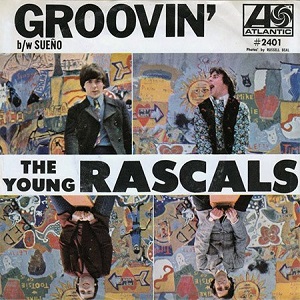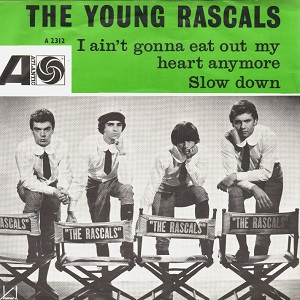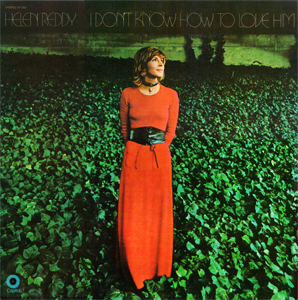
The Rascals are an American rock band, formed in Garfield, New Jersey, United States, in 1965.

Rock Me Baby is the second solo album release from David Cassidy. It was produced by Wes Farrell for Bell Records, and released in 1972. The album introduced some rock, soul and R&B flavors in a calculated move by Cassidy to expand beyond his teen idol image. AllMusic's Al Campbell wrote that the blue-eyed soul album was officially produced by Farrell, but the song selections and styles showed that Cassidy was also making decisions.

Edward Brigati Jr. is an American singer-songwriter. He was the co-lead vocalist, along with Felix Cavaliere, and percussionist in the rock group The Young Rascals from 1964 to 1970.

Felix Cavaliere is an American musician. He is best known for being the co-lead vocalist and keyboard player for The Young Rascals.

That's the Way Love Is is the tenth studio album by soul musician Marvin Gaye, released on January 8, 1970, on the Tamla (Motown) label. Built on the success of the title track originally taken from M.P.G., and much like Gaye's "I Heard It Through The Grapevine" after its success, was released with intent to sell albums based on the success of one particular single. Gaye was showing signs of disillusionment from the label's powers-that-be mentality but it didn't affect the singer's performance as he gave a powerful vocal in the title track and was especially impressive with his version of The Beatles' "Yesterday". He achieved some success with a cover version of "How Can I Forget?", which just missed out on the US Pop Top 40, making #41, and reached #18 on the R&B Charts. Its B-side, a cover of Jimmy Ruffin's "Gonna Give Her All the Love I've Got", made a separate chart entry, and peaked at #67 and #27 on the Pop and Soul Charts respectively. Gaye also recorded a version of Ruffin's "Don't You Miss Me a Little Bit Baby" for the album. The LP also features Gaye's rendition of the socially conscious tune "Abraham, Martin & John", which became a hit in the UK, peaking at #9 in June 1970. The single is widely regarded as a hint of what would follow a year later with his What's Going On. He also covered The Temptations' hits "I Wish It Would Rain" and "Cloud Nine".

"A Place in the Sun" is a 1966 soul single by American and Motown musician Stevie Wonder. Written by Ronald Miller and Bryan Wells, it was one of Wonder's first songs to contain social commentary. "A Place in the Sun" was his third Top Ten hit since 1963, hitting number 9 on the Billboard pop singles chart and number 3 on the R&B charts. Billboard described the song as a "folk-oriented release" to which Wonder gives an "exciting treatment." The Originals and The Andantes sang background vocals on the recording. Stevie Wonder also recorded a version of the song in Italian titled "Il Sole è di Tutti".

Freedom Suite is the fifth studio album by rock band The Rascals, released on March 17, 1969. It peaked at number 17 on the Billboard Top LPs chart and also reached number 40 on the Billboard Black Albums chart, the last Rascals album to appear there.

"Groovin'" is a song written by the American singer songwriters Felix Cavaliere and Eddie Brigati, initially recorded by their group the Young Rascals in 1967. Cavaliere was inspired to compose the song by his girlfriend Adrienne Buccheri, whom he only got to meet every Sunday amidst heavy touring and recording. Musically, the song differs from most of band's previous output, leaving the garage rock genre for Latin American influences, such as baião. Lyrically, "Groovin'" tells the tale of a narrator spending time with his partner on a Sunday afternoon. The song was arranged and recorded at the Talentmasters Studios, New York City in March of 1967.

"People Got to Be Free" is a song released in 1968 by the Rascals, written by Felix Cavaliere and Eddie Brigati and featuring a lead vocal from Cavaliere.

Time Peace: The Rascals' Greatest Hits is a greatest hits album from the Rascals, released on June 24, 1968. It reached number one on the Billboard Pop Albums chart by September 1968. It also topped the Cash Box albums chart with a run in the Top 10 for 20 consecutive weeks
David Brigati is an American singer. He is sometimes known as "the fifth Rascal".

"A Beautiful Morning" is a song written by Felix Cavaliere and Eddie Brigati and recorded by the Rascals. Coming out in early 1968, it was the group's first track released after shortening their name from the Young Rascals. The single was one of the earliest released in stereo, as 7-inch singles generally were in mono. Together with the Doors "Hello, I Love You", it's credited with changing the industry standard of singles.

Groovin' is the third album by the rock band the Young Rascals. The album was released on July 31, 1967 and rose to #5 on the Billboard Top LPs chart, number 7 on the R&B chart, and number 2 in Canada. Eight of the songs were released on singles with the title track reaching number 1 on the Pop chart in the U.S.

Lulu is a 1973 album by Scottish singer Lulu. It was her first album on Chelsea Records. Produced by American songwriter Wes Farrell, the lead single was "Make Believe World". It also included covers of "Groovin'", "Do Right Woman, Do Right Man" and David Cassidy's "Could it Be Forever". The album failed to chart, although Lulu came back to prominence a few months later with the release of the hit single "The Man Who Sold the World". The single reached No.3 in the UK and became one of the singer's biggest hits, but was not included on this album. Although the album met with little chart success, reviews were good, with Allmusic retrospectively calling it "top class".

"I Ain't Gonna Eat Out My Heart Anymore" is a song written by Pam Sawyer and Laurie Burton in 1965. Originally envisioned to be recorded by a British Invasion artist, the song was extremely well liked by the American rock group the Young Rascals, and they subsequently recorded the song and released it as their debut single in November 1965 through Atlantic Records. Though only a marginal hit, reaching number 52 on the Billboard Hot 100, it largely established the band on the American music scene. It has since been included on several albums by the band, including their eponymous debut album, and several compilation albums, including Time Peace: The Rascals' Greatest Hits, on which it was the opening track.

Andy is the thirty-sixth studio album by American pop singer Andy Williams, released in the fall of 1976 by Columbia Records. Williams is not as focused on covering pop hits and standards on this album and instead relies mainly on original or lesser-known songs. In the liner notes for the album's 2002 CD release, writer Richard M. Erickson explains that the album "was recorded at six different studios to accommodate Andy's touring schedule. One recording session was at a portable studio set up at a Marriott hotel."

The Very Best of The Rascals is a compilation album from the Rascals released on July 20, 1993 by Rhino/Atlantic. This compilation contains nearly all of their Atlantic singles, in chronological order, released from 1965 through 1970. The first nine singles are performed by the Young Rascals, while the last seven tracks are credited to the Rascals.

Song Sung Blue is an album by American pop singer Johnny Mathis that was released on September 13, 1972, by Columbia Records and featured his renditions of mostly recent chart hits.

I Don't Know How to Love Him is the debut studio album by Australian-American pop singer Helen Reddy, released on May 10, 1971, by Capitol Records. I Don't Know How to Love Him included her first recording of "I Am Woman". The album made its first appearance on Billboard magazine's Top LP's chart in the issue dated June 5, 1971, and remained there for 37 weeks, peaking at number 100, and got as high as number 40 on the album chart in Canada's RPM magazine. On November 27, 1974, the album received Gold certification from the Recording Industry Association of America, and on March 29, 2005, it was released for the first time on compact disc as one of two albums on one CD, the other album being Reddy's eponymous follow-up that originally came out in the fall of 1971.
"I've Been Lonely Too Long" is a song written by Felix Cavaliere and Eddie Brigati and performed by the Young Rascals. Released as a single in 1967, it reached #7 in Canada, while in the U.S. it reached #16 on the Billboard Hot 100 chart, #17 on the Cashbox Top 100 chart, and #33 on the Hot R&B Singles chart. It was also featured on their 1967 album Collections, where the title is given as "Lonely Too Long".



















